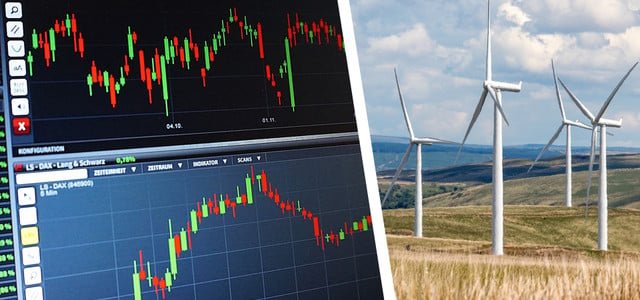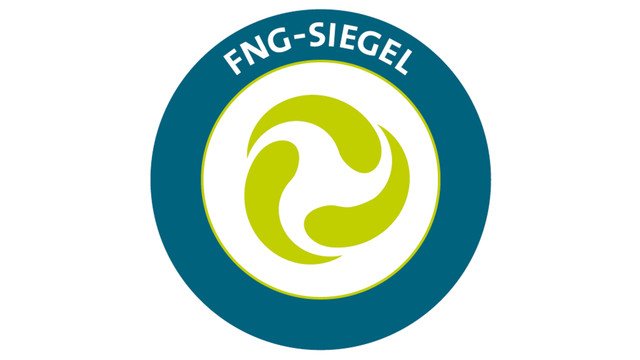Sustainable ETFs: How green are they really?

Exchange-traded funds (ETFs) have been enjoying increasing popularity for several years. For investors without a great deal of expertise, they offer a simple, relatively low-risk and inexpensive entry into the world of shares. Utopia explains when ETFs can make sense, how the popular financial product performs in terms of sustainability and why active funds can be significantly greener than passive funds.
What are ETFs?
Like any fund, an ETF is a collection of different securities, usually shares or bonds. Due to the broad diversification across many different sectors and regions, the risk is spread across hundreds or even thousands of companies and is therefore lower than with individual shares. Funds are often actively managed. This means that fees are charged for a fund manager who selects the shares.
ETFs, on the other hand, are referred to as passive funds and do not require a fund manager, as they always track a specific share index. The best-known share index in Germany is the Dax, which contains the 40 largest listed companies in the country. With an ETF on the Dax, you automatically invest in these top 40.
While most ETFs charge annual costs of 0.1 to 0.5 percent of the investment amount, active funds generally charge 1 to 3 percent. In addition, active funds often charge a front-end load, a one-off fee for the purchase of fund units, which is usually between 0 and 7 percent. There are also smaller one-off order fees for ETFs. However, the significantly more expensive front-end load is usually waived. ETFs are therefore cheaper than active funds and are therefore very popular with private investors.
ETFs on the MSCI World are particularly popular. A Dax ETF has the disadvantage that it only focuses on the German economy. The MSCI World, on the other hand, tracks around 1,500 companies from 23 industrialized countries (with a focus on North America, Europe, Australia and Japan). According to Finanztip, the MSCI World has never made a loss over an investment period of 15 years and has achieved an average annual return of around eight percent. Fixed-interest savings accounts such as fixed-term deposits do not come close to this value.
When do ETFs make sense?
Anyone investing in an ETF must have one thing above all else in addition to the investment capital: a lot of patience. This is because ETFs can lose a lot of value within a very short space of time during financial crises and also have downward swings from time to time during calmer economic phases. If you only want to invest your money for a few months or years, you are taking a risk with ETFs. For short and medium-term investments, fixed-interest savings accounts such as call money and fixed-term deposits are more suitable.
However, the risk decreases as the term increases, as the global economy has always recovered in the long term. If you want to invest in ETFs, you should therefore be able to do without your money for at least ten, preferably even fifteen years or longer. An ETF can be used, for example, for private retirement provision or generally for asset accumulation if you know that you are not planning any major purchases such as a property in the near future.
You should also choose an ETF that covers many different sectors and regions of the world. Sustainable ETFs based on the MSCI World are a good basis. However, as the MSCI World only covers industrialized countries, it can make sense to put at least part of your investment into an emerging market ETF that also includes Brazil, China, India and other important countries.
When do we speak of a sustainable ETF?
For many investors, it is no longer enough to simply increase their money. It should also flow into companies that do not harm the environment, comply with minimum social standards and otherwise operate ethically. An ordinary ETF on the MSCI World does not meet this requirement. This is because it simply contains the largest companies in the industrialized countries in terms of market capitalization, including some companies that disregard human rights or destroy the environment.

Although an ETF designated as sustainable can certainly be based on conventional indices such as the MSCI World and try to replicate them as closely as possible, it must focus on sustainable companies. There are various methods for selecting which stocks are eligible for inclusion in a sustainable ETF. The most common are the following:
Negative or exclusion criteria: Certain sectors are completely excluded from the ETF, for example companies that generate a certain percentage of their turnover from fossil fuels or producers of controversial weapons.
Positive criteria: Companies must meet clearly defined sustainable standards, such as achieving a certain minimum value in a rating.
Best-in-class: Here, the most sustainable representatives of each industry are considered sustainable. This often leads to criticism, as problematic companies are also rated positively simply because they are less bad than their competitors. Under the best-in-class approach, for example, the most sustainable oil company would also end up in the ETF, even though its business area can never be sustainable in itself. However, the best-in-class approach is often combined with exclusion criteria in order to avoid such problems.
Best-of-all-classes: Here, companies are compared across all sectors and only the most sustainable are included in the ETF. This makes the fund sustainable, but also more risky, as certain sectors are very strongly represented and others less so or not at all.
Thematic focus: There are ETFs that only focus on very specific sustainable themes, such as the healthcare sector, renewable energies or special future technologies. However, caution is advised here due to the low diversification.
Engagement: Anyone who holds shares also has voting rights at the annual general meetings of the respective companies in order to help determine the company's share price. The exercise of these rights is called engagement. Some fund providers use engagement to steer companies in a more sustainable direction.
How do I find sustainable ETFs?
To identify sustainable ETFs, fund providers often use abbreviations such as ESG (Environmental, Social & Governance) or SRI (Socially Responsible Investment). However, the meaning of these terms is not standardized and is therefore not a reliable indicator. There are also sustainable funds without ESG or SRI in their name and, conversely, "dirty" funds that only use the abbreviations to give themselves a green veneer.
Independent comparison portals such as Finanztest offer a better decision-making aid. Although access to their extensive fund database is subject to a fee, Finanztest evaluates both sustainability and investment performance. This makes it possible to filter specifically for ETFs that are as sustainable as possible, but also promise a good return with low risk.
ECOreporter also evaluates ETFs independently and competently in terms of sustainability. However, access to the relevant ratings costs significantly more than with Finanztest. It is therefore more of an option for those who are particularly interested and want to delve deeper into the topic.
Free platforms such as Cleanvest or Faire Fonds can also be helpful for checking certain ETFs against sustainability criteria. Cleanvest awards a sustainability rating from 0 to 10, while Faire Fonds shows the proportion of controversial companies in the respective funds.
However, Cleanvest and Faire Fonds are only suitable for a pure sustainability rating. However, your investment strategy should always make financial sense. The worst-case scenario is that you invest in a green niche fund whose value suddenly plummets because that very niche suffers a crisis. So make sure you are well informed before you make a decision.
Are sustainable ETFs also financially worthwhile?
ETFs with a focus on sustainability do not perform worse than conventional ones. In fact, the opposite is the case. A meta-study by the Stern Center for Sustainable Business in New York examined over 1,000 studies on the influence of ESG criteria on companies and investments. 107 of these specifically referred to the differences in returns between conventional investment strategies and those based on ESG criteria. 33 percent of the studies indicated a positive influence and only 14 percent a negative one. For the rest, the result was mixed or neutral.
How sustainable can an ETF really be?
Even though ETFs offer a good opportunity for long-term wealth accumulation from a financial perspective, even the greenest of them are only sustainable to a limited extent.
In August 2023, Finanztest conducted one of the most comprehensive investigations of funds and ETFs to date in terms of sustainability factors. While eight of the active funds received the top score of 5 possible points, not a single index fund scored more than a mediocre 3 points .
A look at the exclusion criteria of the individual funds shows that even the most sustainable of the ETFs tested do not exclude all problematic sectors and still have room for improvement in areas such as fossil fuels, nuclear power and conventional weapons. The "BNP Easy MSCI World SRI S-Series PAB 5% Capped" is one of the best performers, although it does allow animal testing and pornography and only partially excludes gambling and alcohol. Finanztest's conclusion on ETFs is therefore: "They are medium green at best."
The Forum Nachhaltige Geldanlagen (FNG), which awards a seal of approval to sustainable funds every year, comes to a similar conclusion. In 2023, the FNG seal was only awarded to a single ETF, namely the "L&G Healthcare Breakthrough UCITS", which received two out of three possible stars. By comparison, a total of 289 active funds were awarded in the same period.

Among the leading sustainable banks in Germany, only EthikBank offers a custody account with ETFs. GLS Bank, Triodos Bank and UmweltBank deliberately do not. Laurenz Fuchs, fund expert at UmweltBank, explains on his company's website: "In our view, ETFs cannot offer a truly green investment - at least so far. The underlying indices do not even come close to meeting UmweltBank's strict ecological and social criteria. The green ETF advertising promises a lot, but a closer look at the ETFs is disappointing."
It is in the nature of things that ETFs cannot be as sustainable as active funds. With active funds, there are fund managers who regularly scrutinize the individual companies and can examine their sustainability in detail. This is not possible with an ETF, where sustainability criteria can only be applied very superficially.
Conclusion: active funds are the more sustainable alternative
When it comes to sustainability, active funds are better than ETFs, but less profitable due to the higher costs. Whether index funds are suitable for you therefore depends on your sustainability requirements. There are therefore two possible strategies, depending on whether you prefer returns or sustainability:
With the light green strategy, you do pay attention to sustainability, but only insofar as it does not harm your return. Here, broadly diversified ETFs that track an established benchmark index such as the MSCI World and apply the strictest possible sustainability criteria by ETF standards are particularly suitable. According to Finanztest, these include the "BNP Easy MSCI World S-Series PAB 5% Capped" (ISIN: LU1291108642) and the "iShares MSCI World SRI" (ISIN: IE00BYX2JD69). However, it is almost inevitable that shares in companies with questionable social or environmental credentials will end up in your portfolio.
With the dark green strategy, on the other hand, sustainability has top priority. Here, too, you rely on a broadly diversified equity fund that promises a high return with low risk. However, you are using an actively managed fund with a very high level of sustainability. Finanztest recommends, among others, the "terAssisi Aktien" (ISIN: DE0009847343) and the "Green Effects NAI-Werte Fonds" (ISIN: IE0005895655), but ethical banks also often offer corresponding funds. It could hardly be greener, but you also have to bear somewhat higher costs than with an ETF, which reduces the financial prospects.
More on this topic
https://medium.com/@StorySculptres/how-to-get-the-most-out-of-my-profile-6cb9e69ec59f
Yours Forevermore,
